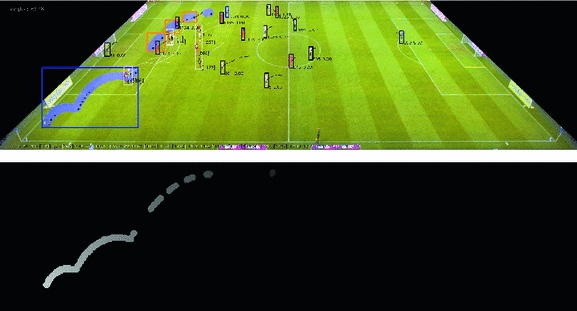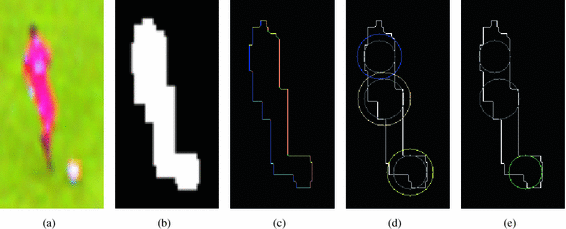Fig. 1.
(a) Variety of the appearance of the ball extracted from one image sequence and (b) examples for partially occluded situations.
The main contribution of this work is the detection of the ball in situations in which the ball is close to a player or even partially covered by one. Detection of the ball in image sequences generally is a difficult task as the appearance of the ball varies from image to image. For instance, the high accelerations occurring at the ball may cause motion blur so that the shape of the ball is then more of an ellipse than a circle (see Fig. 1(a)). In addition, the color of the ball may vary from image to image due to changes of the illumination conditions. It might also have the same color as the lines of the pitch which exacerbates the ball detection task. Another challenge is the image resolution of the ball which is usually very small so that confusions with player body parts may occur. Depending on the camera perspective, the ball is in front of a complex image background such as the audience which exacerbates its detection as well. Besides difficulties that arise from the appearance of the ball itself, the detection of the ball is very challenging in situations where it is occluded by the players (see Fig. 1(b)). Every time a player touches the ball there is a chance that the ball is not fully visible for a short time as parts of the player’s body can move between ball and the camera. However, as long as the ball is at least partially visible, there is an opportunity to identify the ball in the image.


Fig. 2.
Sample snapshot of the processed input image sequence including detected ball tracklets marked by rectangles (top) and one for the corresponding motion history image (bottom).
The motivation of this work is to find a solution which can help to detect the ball in such cases. At the first stage, a circle detection method is applied. At the second stage, the detected circles are evaluated by examining the Freeman chain code [6] of the found contours. There are several publications for detecting and tracking the soccer ball as seen in [2]. However, most of these approaches focus on tracking the ball in broadcast soccer videos and require a high image resolution [3]. The approach presented in this contribution is applicable to static camera systems, even for low-resolution cameras. So it can be used in huge tracking systems consisting of several cameras usually fixed installed in stadiums as well as for low-cost tracking systems that generally consist of 1–3 cameras capturing the entire pitch.
The contribution is structured as follows: In Sect. 2, the module for the ball detection is described. It is a two-stage approach: At the first stage, the ball is detected in situations in which it is generally not occluded. Robust partial ball trajectories (tracklets) are extracted. In order to acquire detection hypotheses in occluded situations (within the gaps between the tracklets), a ball detector specialized for occluded situations is used at the second stage. Then, in Sect. 3, results of an evaluation on data sets of a Bundesliga match are presented.
2 Ball Detection
The reconstruction of the ball trajectory requires a reliable soccer ball detection. However, this is challenging as there are usually a lot of occlusions. Furthermore, a high detection rate should be achieved at a low false alarm rate. We follow a detection approach that has been widely established in order to be able to fulfill this requirement (see e.g. [2]): the detection task is divided into two stages in which ball candidates are extracted and verified. First stage: in not occluded situations the ball is detected and confirmed by its appearance as a single object. Second stage: if there is a (partially) occluded situation which means that the ball has not been detected as a single object, a two-step approach is applied that first detects circles in the image and then analyzes the Freeman chain code [6].


Fig. 3.
(a) Input image, (b) foreground/background segmentation of the input image, (c) chain code representation of the outer contour:  – and
– and  -values (yellow and light blue/horizontal lines) of the chain code are of particular interest, (d) detected Hough circles (gray/smaller circles) and circular RoI
-values (yellow and light blue/horizontal lines) of the chain code are of particular interest, (d) detected Hough circles (gray/smaller circles) and circular RoI  in which the CCH is calculated (blue/upper, brown/central and yellow/lower circle), (e) detected Hough circles and identified ball (green/lower cirlce) (Color figure online).
in which the CCH is calculated (blue/upper, brown/central and yellow/lower circle), (e) detected Hough circles and identified ball (green/lower cirlce) (Color figure online).
 – and
– and  -values (yellow and light blue/horizontal lines) of the chain code are of particular interest, (d) detected Hough circles (gray/smaller circles) and circular RoI
-values (yellow and light blue/horizontal lines) of the chain code are of particular interest, (d) detected Hough circles (gray/smaller circles) and circular RoI  in which the CCH is calculated (blue/upper, brown/central and yellow/lower circle), (e) detected Hough circles and identified ball (green/lower cirlce) (Color figure online).
in which the CCH is calculated (blue/upper, brown/central and yellow/lower circle), (e) detected Hough circles and identified ball (green/lower cirlce) (Color figure online).2.1 Not Occluded Situations
At the first stage, the soccer ball has to be detected as a single object. Due to the real-time constraint for live applications, a feature-based detection with e.g. a sliding windows approach cannot be used. Instead, as the images from a static camera are captured, the foreground/background segmentation from Kim et al. [4] is applied at first. Temporal static background like the pitch and marking lines are segmented as background, whereas moving objects generate changing appearance and are therefore segmented as foreground. During the ball candidate extraction, all foreground regions are extracted and checked for their size using calibration information of the cameras. Foreground regions that are no candidates for the soccer ball due to their size are removed. Out of the remaining regions, the external contours are extracted as a sequence of points and analyzed afterwards. If the number of the contour pixels is higher than a specific bias, an ellipse is fitted to it and the mean squared error between every sequence point and the ellipse is calculated. Ball candidates with a high mean squared error are removed. The remaining candidates are kept as verified foreground regions in the foreground/background segmented image. Then, a dilatation is applied and the last  binary images are accumulated to a so-called Motion History Image (MHI) of verified ball candidates. Finally, ball tracklets (robust partial ball trajectories) are finally extracted from the MHI. Figure 2 shows a MHI and some results of detected/extracted ball tracklets.
binary images are accumulated to a so-called Motion History Image (MHI) of verified ball candidates. Finally, ball tracklets (robust partial ball trajectories) are finally extracted from the MHI. Figure 2 shows a MHI and some results of detected/extracted ball tracklets.
 binary images are accumulated to a so-called Motion History Image (MHI) of verified ball candidates. Finally, ball tracklets (robust partial ball trajectories) are finally extracted from the MHI. Figure 2 shows a MHI and some results of detected/extracted ball tracklets.
binary images are accumulated to a so-called Motion History Image (MHI) of verified ball candidates. Finally, ball tracklets (robust partial ball trajectories) are finally extracted from the MHI. Figure 2 shows a MHI and some results of detected/extracted ball tracklets.2.2 Partially Occluded Situations
The foreground/background segmentation of the first stage often merges ball and player into a single silhouette if they are either close to each other or partially occlude each other. Thus, the ball is not a singular object and only appears as a bump poking out of the player’s silhouette in the resulting image (Fig. 3(a) and (b)).
At the second stage, the goal is to identify these bumps. In order to achieve this, we apply a two-step approach again. In the first step, circles (or at least parts of circles) in the image are detected via Hough transform [5]. In the second step, the Freeman chain code is considered to decide if a detected circle is a soccer ball.
Stay updated, free articles. Join our Telegram channel

Full access? Get Clinical Tree







